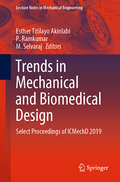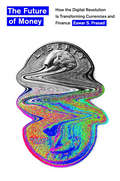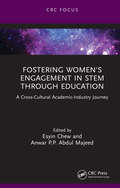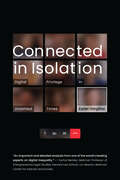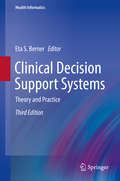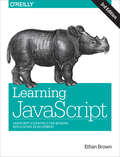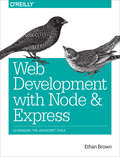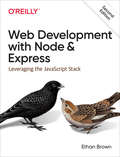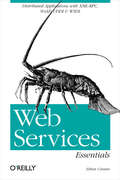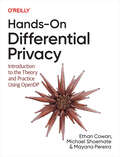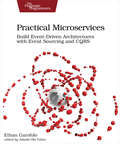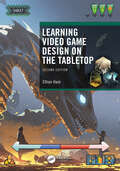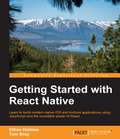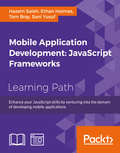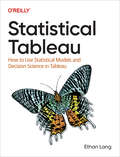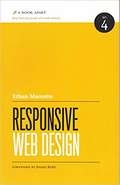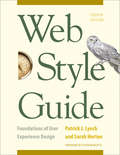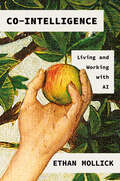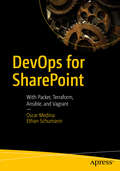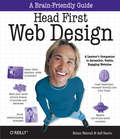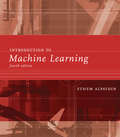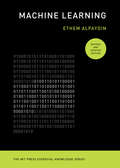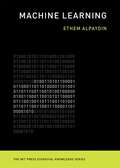- Table View
- List View
Trends in Mechanical and Biomedical Design: Select Proceedings of ICMechD 2019 (Lecture Notes in Mechanical Engineering)
by Esther Titilayo Akinlabi P. Ramkumar M. SelvarajThis book comprises select papers presented at the International Conference on Mechanical Engineering Design (ICMechD) 2019. The volume focuses on the recent trends in design research and their applications across the mechanical and biomedical domain. The book covers topics like tribology design, mechanism and machine design, wear and surface engineering, vibration and noise engineering, biomechanics and biomedical engineering, industrial thermodynamics, and thermal engineering. Case studies citing practical challenges and their solutions using appropriate techniques and modern engineering tools are also discussed. Given its contents, this book will prove useful to students, researchers as well as practitioners.
The Future of Money: How the Digital Revolution Is Transforming Currencies and Finance
by Eswar S. PrasadA cutting-edge look at how accelerating financial change, from the end of cash to the rise of cryptocurrencies, will transform economies for better and worse. We think we’ve seen financial innovation. We bank from laptops and buy coffee with the wave of a phone. But these are minor miracles compared with the dizzying experiments now underway around the globe, as businesses and governments alike embrace the possibilities of new financial technologies. As Eswar Prasad explains, the world of finance is at the threshold of major disruption that will affect corporations, bankers, states, and indeed all of us. The transformation of money will fundamentally rewrite how ordinary people live. Above all, Prasad foresees the end of physical cash. The driving force won’t be phones or credit cards but rather central banks, spurred by the emergence of cryptocurrencies to develop their own, more stable digital currencies. Meanwhile, cryptocurrencies themselves will evolve unpredictably as global corporations like Facebook and Amazon join the game. The changes will be accompanied by snowballing innovations that are reshaping finance and have already begun to revolutionize how we invest, trade, insure, and manage risk. Prasad shows how these and other changes will redefine the very concept of money, unbundling its traditional functions as a unit of account, medium of exchange, and store of value. The promise lies in greater efficiency and flexibility, increased sensitivity to the needs of diverse consumers, and improved market access for the unbanked. The risk is instability, lack of accountability, and erosion of privacy. A lucid, visionary work, The Future of Money shows how to maximize the best and guard against the worst of what is to come.
Fostering Women's Engagement in STEM Through Education: A Cross-Cultural Academic-Industry Journey
by Esyin Chew Majeed, Anwar P.P. AbdulFostering Women's Engagement in STEM Through Education: A Cross-Cultural Academic-Industry Journey uniquely intertwines academic rigour with real-world impact, offering a comprehensive exploration of science, technology, engineering, and mathematics (STEM) experiences forged through the Partnership for Innovation in Employability (PIE) programme. The PIE programme, funded by the British Council, is aimed at nurturing innovation and facilitating interaction to enhance employability within educational robotics.This book brings together participating universities and industry partners from across the world to celebrate and share a variety of case studies showcasing the application of STEM education in various settings – from industrial to primary education. It not only illuminates successes, but critically evaluates challenges faced, and concludes with a look to the future for women in STEM education, research, and professional roles.Key features:· Offers a comprehensive, global perspective on the challenges and opportunities in promoting gender equality and diversity in STEM fields through education and outreach programmes, featuring case studies from Wales and Malaysia.· Provides actionable insights and recommendations for educators, policymakers, and stakeholders to develop and implement effective strategies for bridging the STEM gender gap and fostering inclusivity in education.· Explores innovative pedagogical approaches, such as game-based learning using traditional folk games, and the integration of cutting-edge technologies (e.g. collaborative robots) to engage learners from diverse backgrounds.This serves as a key resource for individuals engaged in professions connected to and researching STEM education, especially those dedicated to promoting and enhancing women's involvement in these fields.
Connected in Isolation: Digital Privilege in Unsettled Times
by Eszter HargittaiWhat life during lockdown reveals about digital inequality.The vast majority of people in wealthy, highly connected, or digitally privileged societies may have crossed the digital divide, but being online does not mean that everyone is equally connected—and digital inequality reflects experience both online and off. In Connected in Isolation Eszter Hargittai looks at how this digital disparity played out during the unprecedented isolation imposed in the early days of the coronavirus pandemic. During initial COVID-19 lockdowns the Internet, for many, became a lifeline, as everything from family get-togethers to doctor&’s visits moved online. Using survey data collected in April and May of 2020 in the United States, Italy, and Switzerland, Hargittai explores how people from varied backgrounds and differing skill levels were able to take advantage of digital media to find the crucial information they needed—to help loved ones, procure necessities, understand rules and risks. Her study reveals the extent to which long-standing social and digital inequalities played a critical role in this move toward computer-mediated communication—and were often exacerbated in the process. However, Hargittai notes, context matters: her findings reveal that some populations traditionally disadvantaged with technology, such as older people, actually did better than others, in part because of the continuing importance of traditional media, television in particular. The pandemic has permanently shifted how reliant we are upon online information, and the implications of Hargittai&’s groundbreaking comparative research go far beyond the pandemic. Connected in Isolation informs and expands our understanding of digital media, including how they might mitigate or worsen existing social disparities; whom they empower or disenfranchise; and how we can identify and expand the skills people bring to them.
Clinical Decision Support Systems: Theory and Practice (Health Informatics)
by Eta S. BernerBuilding on the success of the previous editions, this fully updated book once again brings together worldwide experts to illustrate the underlying science and day-to-day use of decision support systems in clinical and educational settings. Topics discussed include: -Mathematical Foundations of Decision Support Systems -Design and Implementation Issues -Ethical and Legal Issues in Decision Support -Clinical Trials of Information Interventions -Hospital-Based Decision Support -Real World Case Studies
Learning JavaScript: JavaScript Essentials for Modern Application Development
by Ethan BrownThis is an exciting time to learn JavaScript. Now that the latest JavaScript specification—ECMAScript 6.0 (ES6)—has been finalized, learning how to develop high-quality applications with this language is easier and more satisfying than ever. This practical book takes programmers (amateurs and pros alike) on a no-nonsense tour of ES6, along with some related tools and techniques.Author Ethan Brown (Web Development with Node and Express) not only guides you through simple and straightforward topics (variables, control flow, arrays), but also covers complex concepts such as functional and asynchronous programming. You’ll learn how to create powerful and responsive web applications on the client, or with Node.js on the server.Use ES6 today and transcompile code to portable ES5Translate data into a format that JavaScript can useUnderstand the basic usage and mechanics of JavaScript functionsExplore objects and object-oriented programmingTackle new concepts such as iterators, generators, and proxiesGrasp the complexities of asynchronous programmingWork with the Document Object Model for browser-based appsLearn Node.js fundamentals for developing server-side applications
Web Development with Node and Express
by Ethan BrownThe Express web application framework for Node strikes the ideal balance between a robust framework and no framework at all. Many web frameworks try to do so much that they become inflexible and overly complicated, having a negative effect on both learning curve and ability to customize. Express takes a much more agnostic approach, allowing developers a free hand in their architecture choices. It is a joy to work with, and this book is designed not only to introduce the framework, but also to provide some guidance about how to go about doing things that more elaborate (and inflexible) frameworks provide.Even though there is plenty of material on the topic of Express alone, Web Development with Node and Express will provide you additional value because it also covers best practices in web architecture. Ideal for those new to JavaScript, this book also shows experienced JavaScript developers have started to look towards Express as a viable alternative for web development.As someone who deals every day with the complexities of real-world websites, author Ethan Brown offers tremendous wisdom and experience for people interested in producing high-quality, fast, maintainable websites that are friendly to SEO and analytics.This book covers Express 4.0.
Web Development with Node and Express: Leveraging the JavaScript Stack
by Ethan BrownBuild dynamic web applications with Express, a key component of the Node/JavaScript development stack. In this updated edition, author Ethan Brown teaches you Express fundamentals by walking you through the development of an example application. This hands-on guide covers everything from server-side rendering to API development suitable for usein single-page apps (SPAs).Express strikes a balance between a robust framework and no framework at all, allowing you a free hand in your architecture choices. Frontend and backend engineers familiar with JavaScript will also learn best practices for building multipage and hybrid web apps with Express. Pick up this book anddiscover new ways to look at web development.Create a templating system for rendering dynamic dataDive into request and response objects, middleware, and URL routingSimulate a production environment for testingPersist data in document databases with MongoDB and relational databases with PostgreSQLMake your resources available to other programs with APIsBuild secure apps with authentication, authorization, and HTTPSIntegrate with social media, geolocation, and moreImplement a plan for launching and maintaining your appLearn critical debugging skills
Web Services Essentials: Distributed Applications with XML-RPC, SOAP, UDDI & WSDL
by Ethan CeramiAs a developer new to Web Services, how do you make sense of this emerging framework so you can start writing your own services today? This concise book gives programmers both a concrete introduction and a handy reference to XML web services, first by explaining the foundations of this new breed of distributed services, and then by demonstrating quick ways to create services with open-source Java tools.Web Services make it possible for diverse applications to discover each other and exchange data seamlessly via the Internet. For instance, programs written in Java and running on Solaris can find and call code written in C# that run on Windows XP, or programs written in Perl that run on Linux, without any concern about the details of how that service is implemented. A common set of Web Services is at the core of Microsoft's new .NET strategy, Sun Microsystems's Sun One Platform, and the W3C's XML Protocol Activity Group.In this book, author Ethan Cerami explores four key emerging technologies:XML Remote Procedure Calls (XML-RPC)SOAP - The foundation for most commercial Web Services developmentUniversal Discovery, Description and Integration (UDDI)Web Services Description Language (WSDL)For each of these topics, Web Services Essentials provides a quick overview, Java tutorials with sample code, samples of the XML documents underlying the service, and explanations of freely-available Java APIs. Cerami also includes a guide to the current state of Web Services, pointers to open-source tools and a comprehensive glossary of terms.If you want to break through the Web Services hype and find useful information on these evolving technologies, look no further than Web Services Essentials.
Hands-On Differential Privacy
by Ethan Cowan Michael Shoemate Mayana PereiraMany organizations today analyze and share large, sensitive datasets about individuals. Whether these datasets cover healthcare details, financial records, or exam scores, it's become more difficult for organizations to protect an individual's information through deidentification, anonymization, and other traditional statistical disclosure limitation techniques. This practical book explains how differential privacy (DP) can help.Authors Ethan Cowan, Michael Shoemate, and Mayana Pereira explain how these techniques enable data scientists, researchers, and programmers to run statistical analyses that hide the contribution of any single individual. You'll dive into basic DP concepts and understand how to use open source tools to create differentially private statistics, explore how to assess the utility/privacy trade-offs, and learn how to integrate differential privacy into workflows.With this book, you'll learn:How DP guarantees privacy when other data anonymization methods don'tWhat preserving individual privacy in a dataset entailsHow to apply DP in several real-world scenarios and datasetsPotential privacy attack methods, including what it means to perform a reidentification attackHow to use the OpenDP library in privacy-preserving data releasesHow to interpret guarantees provided by specific DP data releases
Practical Microservices: Build Event-Driven Architectures with Event Sourcing and CQRS
by Ethan GarofoloMVC and CRUD make software easier to write, but harder to change. Microservice-based architectures can help even the smallest of projects remain agile in the long term, but most tutorials meander in theory or completely miss the point of what it means to be microservice-based. Roll up your sleeves with real projects and learn the most important concepts of evented architectures. You'll have your own deployable, testable project and a direction for where to go next. Much ink has been spilled on the topic of microservices, but all of this writing fails to accurately identity what makes a system a monolith, define what microservices are, or give complete, practical examples, so you're probably left thinking they have nothing to offer you. You don't have to be at Google or Facebook scale to benefit from a microservice-based architecture. Microservices will keep even small and medium teams productive by keeping the pieces of your system focused and decoupled. Discover the basics of message-based architectures, render the same state in different shapes to fit the task at hand, and learn what it is that makes something a monolith (it has nothing to do with how many machines you deploy to). Conserve resources by performing background jobs with microservices. Deploy specialized microservices for registration, authentication, payment processing, e-mail, and more. Tune your services by defining appropriate service boundaries. Deploy your services effectively for continuous integration. Master debugging techniques that work across different services. You'll finish with a deployable system and skills you can apply to your current project.Add the responsiveness and flexibility of microservices to your project, no matter what the size or complexity.What You Need:While the principles of this book transcend programming language, the code examples are in Node.js because JavaScript, for better or worse, is widely read. You'll use PostgreSQL for data storage, so familiarity with it is a plus. The books does provide Docker images to make working with PostgreSQL a bit easier, but extensive Docker knowledge is not required.
Learning Video Game Design on the Tabletop
by Ethan HamLearn the mechanics that take your game from an idea to a playable product.Do you aspire to be a game designer but aren’t sure where to begin? Learning Video Game Design on the Tabletop guides you through your initial attempts to design game mechanics. It goes beyond simple description and definition to explore in detail the issues that designers grapple with for every game they create.Learning to design tabletop games builds a solid foundation for game designers and provides methods that can be applied towards creating paper prototypes of computer-targeted games. Presented in a step-by-step format, this book helps the reader understand how the game design skills that are acquired through creating tabletop games can be used when designing video games. Fully playable games accompany every topic so you can truly understand and experience each component that goes into game creation.The Second Edition includes: Simple, highly focused games that can be played, analyzed, improved, and/or modified in conjunction with a particular topic in the book Integrated game design exercises, chapter learning objectives, and in-text sidebars to provide further examples to apply directly to your game creation process Essays from professional tabletop and video game designers in which they describe their professional journeys and design philosophies.
Tabletop Game Design for Video Game Designers
by Ethan Ham<p>Learn the mechanics that take your game from an idea to a playable product. <p>Do you aspire to be a game designer but aren’t sure where to begin? Tabletop Game Design for Video Game Designers guides you through your initial attempts to design game mechanics. It goes beyond simple description and definition to explore in detail the issues that designers grapple with for every game they create. <p>Learning to design tabletop games builds a solid foundation for game designers and provides methods that can be applied towards creating paper prototypes of computer-targeted games. Presented in a step-by-step format, Tabletop Game Design for Video Game Designers helps the reader understand how the game design skills that are acquired through creating tabletop games can be used when designing video games. Fully playable games accompany every topic so you can truly understand and experience each component that goes into game creation. <p>Tabletop Game Design for Video Game Designers includes: <p> <li>Simple, highly focused games that can be played, analyzed, improved, and/or modified in conjunction with a particular topic in the book. <li>Integrated game design exercises, chapter learning objectives, and in-text sidebars to provide further examples to apply directly to your game creation process. <li>A companion website (www.funmines.com) which includes: "print & play" tabletop games, links to online games, game design resources, and articles about designing and developing games.</li> </p>
Getting Started with React Native
by Tom Bray Ethan HolmesLearn to build modern native iOS and Android applications using JavaScript and the incredible power of React About This Book * Learn to design and build a fully-featured application using the newest cutting-edge framework from Facebook * Leverage your JavaScript skills to become a native app developer * Develop custom UI components, implement smooth navigation, and access native features such as geolocation and local storage Who This Book Is For This book is for web developers who want to learn to build fast, good-looking, native mobile applications using the skills they already have. If you already have some JavaScript knowledge or are using React on the web, then you will be able to quickly get up and running with React Native for iOS and Android. What You Will Learn * Set up the React Native environment on both devices and emulators * Gain an in-depth understanding of how React Native works behind the scenes * Write your own custom native UI components * Learn the ins and outs of screen navigation * Master the art of layout and styles * Work with device-exclusive data such as geolocation * Develop native modules in Objective-C and Java that interact with JavaScript * Test and deploy your application for a production-ready environment In Detail React Native is a game-changing approach to hybrid mobile development. Web developers can leverage their existing skills to write mobile applications in JavaScript that are truly native without using cross-compilation or web views. These applications have all of the advantages of those written in Objective-C or Java, combined with the rapid development cycle that JavaScript developers are accustomed to. Web developers who want to develop native mobile applications face a high barrier to entry, because they are forced to learn platform-specific languages and frameworks. Numerous hybrid technologies have tried to simplify this process, but have failed to achieve the performance and appearance that users expect. This book will show you all the advantages of true native development that React Native has without the steep learning curve, leveraging the knowledge you already have. We do this by getting you up and running quickly with a sample application. Next, we'll introduce you to the fundamentals of creating components and explain how React Native works under the hood. Once you have established a solid foundation, you will dive headfirst into developing a real-world application from start to finish. Along the way, we will demonstrate how to create multiple screens and navigate between them,use layout and style native UI components, and access native APIs such as local storage and geolocation. Finally, we tackle the advanced topic of Native modules, which demonstrates that there are truly no limits to what you can do with React Native. Style and approach This book provides a simple and easy way to build mobile applications in JavaScript. Each topic takes you through the life cycle of creating a fully-functional native app, with detailed explanations of the entire process.
Mobile Application Development: Using JavaScript Descendent Technologies
by Hazem Saleh Tom Bray Ethan Holmes Sani YusufEnhance your JavaScript skills by venturing into the domain of developing mobile applications About This Book * Extend your JavaScript skillset to build, test, and launch mobile apps with confidence * Follow three sample projects to experience Ionic's impressive capabilities * Extend the power of Apache Cordova by creating your own Apache Cordova cross-platform mobile plugins Who This Book Is For This Learning Path is for JavaScript web developers looking to develop mobile applications using various JavaScript descendent technologies. It is for anyone who wants to learn how to build fast and stylish native mobile app using the skills they already have. If you are already using React on the web, we're confident you'll be able to quickly get up and running with React Native for iOS and Android. See Ionic in action, and find out how it can transform the way you build mobile apps. What You Will Learn * Develop, build, run, and deploy great cross-platform mobile applications using Apache Cordova * Create complete mobile apps using Apache Cordova that runs on Apple iOS, Google Android, and Windows Phone * Create a neat user interface for your mobile application using jQuery Mobile * Gain an in-depth understanding of how React Native works behind the scenes * Write your own custom native UI components * Develop native modules in Objective-C and Java that interact with JavaScript * Get to know Ionic by creating three complete mobile applications In Detail A great mobile app is rapidly becoming crucial for a huge range of businesses. With a great app, your customers or your readers don't come to you - you go with them, just a few clicks and swipes away. This Learning Path shows you how to build awesome mobile apps with some of the best tools currently being used by some of the smartest developers in the industry. Taking you through JavaScript impressive development ecosystem - from jQuery Mobile to React, through to Ionic - we'll show you how to put your skills into practice so you can build your next mobile apps with confidence and style. In this Learning Path, from jQuery to React, to Ionic, we'll cover everything you need to start In the first module you'll learn how to get stuck into Apache Cordova and find out how to use it as the key platform for developing your mobile app. It offers an efficient way to develop hybrid apps, which means you won't have to connect to platform specific APIs or use their UI framework, and can instead harness your JavaScript web development skills. Make sure you have your HTML, CSS and jQuery skills at the ready. In Module 2 we'll show you how to take advantage of React Native. It has a reputation for having a steep learning curve, but we'll make it easy for you, making sure you make full use of your existing knowledge and getting you up and running with a sample application. You'll also learn how to create components, how to create multiple screens, as well as using native UI components and accessing native APIs. In the third and final module you'll get started with Ionic. With three practical projects you can build yourself, we've made sure that you'll be learning by doing - which means you'll not only develop new skills much more quickly, but you'll have produced something tangible at the end of it! This Learning Path combines some of the best that Packt has to offer in one complete, curated package. It includes content from the following Packt products: * JavaScript Mobile Application Development by Hazem Saleh * Getting Started with React Native by Ethan Holmes and Tom Bray * Ionic Framework By Example by Sani Yusuf Style and approach This Learning Path course provides a simple and easy way to build mobile applications in JavaScript descendent technologies such as jQuery, ReactJS, and Ionic.
Statistical Tableau: How to Use Statistical Models and Decision Science in Tableau
by Ethan LangIn today's data-driven world, understanding statistical models is crucial for effective analysis and decision making. Whether you're a beginner or an experienced user, this book equips you with the foundational knowledge to grasp and implement statistical models within Tableau. Gain the confidence to speak fluently about the models you employ, driving adoption of your insights and analysis across your organization.As AI continues to revolutionize industries, possessing the skills to leverage statistical models is no longer optional—it's a necessity. Stay ahead of the curve and harness the full potential of your data by mastering the ability to interpret and utilize the insights generated by these models.Whether you're a data enthusiast, analyst, or business professional, this book empowers you to navigate the ever-evolving landscape of data analytics with confidence and proficiency. Start your journey toward data mastery today.In this book, you will learn:The basics of foundational statistical modeling with TableauHow to prove your analysis is statistically significantHow to calculate and interpret confidence intervalsBest practices for incorporating statistics into data visualizationsHow to connect external analytics resources from Tableau using R and Python
Responsive Web Design (Brief Books for People Who Make Websites #4)
by Ethan MarcotteLearn how to think beyond the desktop and craft beautiful designs that anticipate and respond to your users' needs. The author will explore CSS techniques and design principles, including fluid grids, flexible images, and media queries, demonstrating how you can deliver a quality experience to your users no matter how large (or small) their display.
Web Style Guide: Foundations of User Experience Design
by Patrick Lynch Sarah Horton Ethan MarcotteA classic reference book on user interface design and graphic design for web sites, updated to reflect a rapidly changing market Consistently praised as the best volume on classic elements of web site design, Web Style Guide has sold many thousands of copies and has been published around the world. This new revised edition confirms Web Style Guide as the go-to authority in a rapidly changing market. As web designers move from building sites from scratch to using content management and aggregation tools, the book's focus shifts away from code samples and toward best practices, especially those involving mobile experience, social media, and accessibility. An ideal reference for web site designers in corporations, government, nonprofit organizations, and academic institutions, the book explains established design principles and covers all aspects of web design--from planning to production to maintenance. The guide also shows how these principles apply in web design projects whose primary concerns are information design, interface design, and efficient search and navigation.
Co-Intelligence: Living and Working With AI
by Ethan MollickFrom Wharton professor and author of the popular One Useful Thing Substack newsletter Ethan Mollick comes the definitive playbook for working, learning, and living in the new age of AI <p><p> Something new entered our world in November 2022 — the first general purpose AI that could pass for a human and do the kinds of creative, innovative work that only humans could do previously. Wharton professor Ethan Mollick immediately understood what ChatGPT meant: after millions of years on our own, humans had developed a kind of co-intelligence that could augment, or even replace, human thinking. Through his writing, speaking, and teaching, Mollick has become one of the most prominent and provocative explainers of AI, focusing on the practical aspects of how these new tools for thought can transform our world. <p><p> In Co-Intelligence, Mollick urges us to engage with AI as co-worker, co-teacher, and coach. He assesses its profound impact on business and education, using dozens of real-time examples of AI in action. Co-Intelligence shows what it means to think and work together with smart machines, and why it’s imperative that we master that skill. <p><p> Mollick challenges us to utilize AI’s enormous power without losing our identity, to learn from it without being misled, and to harness its gifts to create a better human future. Wide ranging, hugely thought-provoking, optimistic, and lucid, Co-Intelligence reveals the promise and power of this new era. <p> <b>New York Times Bestseller</b>
DevOps for SharePoint: With Packer, Terraform, Ansible, and Vagrant
by Oscar Medina Ethan SchumannDeploy a SharePoint farm in a repeatable, predictable, and reliable fashion using Infrastructure as Code (IaC) techniques to automate provisioning. Savvy IT pros will learn how to use DevOps practices and open source tools to greatly reduce costs, and streamline management operations for SharePoint farms deployed via Amazon Web Services (AWS), Azure, or on premise. DevOps for SharePoint will help you navigate the complex challenges of deploying and managing SharePoint Server farms. You will learn how to reduce time-consuming tasks and errors when generating development, testing, or production environments. And you will benefit from learning proven methods to apply Microsoft updates with minimal downtime and productivity loss. Whether you are a SharePoint architect, IT pro, or developer helping customers with the SharePoint platform, this book will teach you the most useful DevOps practices to tackle those issues and broaden your skill set.What You’ll LearnUnderstand the basics of the most popular open source tools—Vagrant, Packer, Terraform, and Ansible—and how to use them in the context of deploying and scaling a SharePoint farmUse Vagrant to build SharePoint development environments in less than an hour, and add automated testingUse Packer to create a “golden image” with preconfigured settings, and then use it as the base image in your Terraform configuration for both AWS and Azure farmsUse Terraform to scale your SharePoint farm topologyUse Red Hat’s Ansible Playbooks to perform configuration management on your farmUse Terraform to deploy immutable infrastructure environments using IaC (Infrastructure as Code)Use InSpec 2.0 to stay in compliance by testing your cloud infrastructureUse Ansible to apply Microsoft updates and patches Who This Book Is ForIT pros and developers who are looking to expand their knowledge and take a modern approach by using open source technologies to work with Microsoft products. Experience installing SharePoint, and a basic understanding of either Azure or AWS, is helpful.
Head First Web Design: A Learner's Companion to Accessible, Usable, Engaging Websites (Head First)
by Jeff Siarto Ethan WatrallWant to know how to make your pages look beautiful, communicate your message effectively, guide visitors through your website with ease, and get everything approved by the accessibility and usability police at the same time? Head First Web Design is your ticket to mastering all of these complex topics, and understanding what's really going on in the world of web design.Whether you're building a personal blog or a corporate website, there's a lot more to web design than div's and CSS selectors, but what do you really need to know? With this book, you'll learn the secrets of designing effective, user-friendly sites, from customer requirements to hand-drawn storyboards all the way to finished HTML and CSS creations that offer an unforgettable online presence.The revised two-color edition of this book includes a free online version of the chapter on web color. You can easily access this chapter at Oreilly.com once you register your book.Your time is way too valuable to waste struggling with new concepts. Using the latest research in cognitive science and learning theory to craft a multi-sensory learning experience, Head First Web Design uses a visually rich format specifically designed to take advantage of the way your brain really works.
Introduction to Machine Learning, fourth edition (Adaptive Computation and Machine Learning series)
by Ethem AlpaydinA substantially revised fourth edition of a comprehensive textbook, including new coverage of recent advances in deep learning and neural networks.The goal of machine learning is to program computers to use example data or past experience to solve a given problem. Machine learning underlies such exciting new technologies as self-driving cars, speech recognition, and translation applications. This substantially revised fourth edition of a comprehensive, widely used machine learning textbook offers new coverage of recent advances in the field in both theory and practice, including developments in deep learning and neural networks.The book covers a broad array of topics not usually included in introductory machine learning texts, including supervised learning, Bayesian decision theory, parametric methods, semiparametric methods, nonparametric methods, multivariate analysis, hidden Markov models, reinforcement learning, kernel machines, graphical models, Bayesian estimation, and statistical testing. The fourth edition offers a new chapter on deep learning that discusses training, regularizing, and structuring deep neural networks such as convolutional and generative adversarial networks; new material in the chapter on reinforcement learning that covers the use of deep networks, the policy gradient methods, and deep reinforcement learning; new material in the chapter on multilayer perceptrons on autoencoders and the word2vec network; and discussion of a popular method of dimensionality reduction, t-SNE. New appendixes offer background material on linear algebra and optimization. End-of-chapter exercises help readers to apply concepts learned. Introduction to Machine Learning can be used in courses for advanced undergraduate and graduate students and as a reference for professionals.
Machine Learning, revised and updated edition: The New Ai (The MIT Press Essential Knowledge series)
by Ethem AlpaydinA concise overview of machine learning--computer programs that learn from data--the basis of such applications as voice recognition and driverless cars.Today, machine learning underlies a range of applications we use every day, from product recommendations to voice recognition--as well as some we don't yet use everyday, including driverless cars. It is the basis for a new approach to artificial intelligence that aims to program computers to use example data or past experience to solve a given problem. In this volume in the MIT Press Essential Knowledge series, Ethem Alpaydin offers a concise and accessible overview of "the new AI." This expanded edition offers new material on such challenges facing machine learning as privacy, security, accountability, and bias. Alpaydin, author of a popular textbook on machine learning, explains that as "Big Data" has gotten bigger, the theory of machine learning--the foundation of efforts to process that data into knowledge--has also advanced. He describes the evolution of the field, explains important learning algorithms, and presents example applications. He discusses the use of machine learning algorithms for pattern recognition; artificial neural networks inspired by the human brain; algorithms that learn associations between instances; and reinforcement learning, when an autonomous agent learns to take actions to maximize reward. In a new chapter, he considers transparency, explainability, and fairness, and the ethical and legal implications of making decisions based on data.
Machine Learning: The New AI
by Ethem AlpaydinToday, machine learning underlies a range of applications we use every day, from product recommendations to voice recognition -- as well as some we don't yet use everyday, including driverless cars. It is the basis of the new approach in computing where we do not write programs but collect data; the idea is to learn the algorithms for the tasks automatically from data. As computing devices grow more ubiquitous, a larger part of our lives and work is recorded digitally, and as "Big Data" has gotten bigger, the theory of machine learning -- the foundation of efforts to process that data into knowledge -- has also advanced. In this book, machine learning expert Ethem Alpaydin offers a concise overview of the subject for the general reader, describing its evolution, explaining important learning algorithms, and presenting example applications.Alpaydin offers an account of how digital technology advanced from number-crunching mainframes to mobile devices, putting today's machine learning boom in context. He describes the basics of machine learning and some applications; the use of machine learning algorithms for pattern recognition; artificial neural networks inspired by the human brain; algorithms that learn associations between instances, with such applications as customer segmentation and learning recommendations; and reinforcement learning, when an autonomous agent learns act so as to maximize reward and minimize penalty. Alpaydin then considers some future directions for machine learning and the new field of "data science," and discusses the ethical and legal implications for data privacy and security.
Machine Learning: The New AI (The MIT Press Essential Knowledge Series)
by Ethem AlpaydinA concise overview of machine learning—computer programs that learn from data—which underlies applications that include recommendation systems, face recognition, and driverless cars. Today, machine learning underlies a range of applications we use every day, from product recommendations to voice recognition—as well as some we don't yet use everyday, including driverless cars. It is the basis of the new approach in computing where we do not write programs but collect data; the idea is to learn the algorithms for the tasks automatically from data. As computing devices grow more ubiquitous, a larger part of our lives and work is recorded digitally, and as “Big Data” has gotten bigger, the theory of machine learning—the foundation of efforts to process that data into knowledge—has also advanced. In this book, machine learning expert Ethem Alpaydin offers a concise overview of the subject for the general reader, describing its evolution, explaining important learning algorithms, and presenting example applications. Alpaydin offers an account of how digital technology advanced from number-crunching mainframes to mobile devices, putting today's machine learning boom in context. He describes the basics of machine learning and some applications; the use of machine learning algorithms for pattern recognition; artificial neural networks inspired by the human brain; algorithms that learn associations between instances, with such applications as customer segmentation and learning recommendations; and reinforcement learning, when an autonomous agent learns act so as to maximize reward and minimize penalty. Alpaydin then considers some future directions for machine learning and the new field of “data science,” and discusses the ethical and legal implications for data privacy and security.
